Are you someone who enjoys good quality audio in your car? Then you may have heard of a crossover and wondered what it is and how it works. A crossover is an electronic component that enhances the sound quality in car audio systems. It divides the different audio frequencies and sends them to the correct speakers, ensuring that they receive the appropriate range of frequencies for optimal performance.
A crossover is an essential component in any car audio system as it not only provides better sound quality but also protects your speakers from damage. Understanding what a crossover does and how it works is crucial for any car audio enthusiast looking to elevate their listening experience.
Key Takeaways
- A crossover is an electronic component that enhances sound quality in car audio systems.
- It divides different audio frequencies and sends them to the correct speakers.
- A crossover is essential for protecting speakers from damage.
Types of Crossovers in Car Audio
There are several types of crossovers used in car audio systems, each with its own unique benefits. Understanding the differences between them can help you choose the right one for your setup. Below are some of the most common types:
- Passive crossovers: These are the most common type of crossover in car audio systems. They are easy to install and require no external power source. Passive crossovers work by using capacitors, inductors, and resistors to filter out unwanted frequencies and send the appropriate frequencies to the right speakers. They are relatively inexpensive and can be found in most speaker systems.
- Active crossovers: These crossovers require an external power source and have a more complex design than passive crossovers. They are able to provide more accurate filtering and can handle a higher power load. Active crossovers are often used in high-end car audio systems and require professional installation.
- Electronic crossovers: Electronic crossovers are similar to active crossovers but use digital signal processing (DSP) to separate frequencies. They offer more precise control over crossover points and slope rates, resulting in better sound quality. Electronic crossovers can be standalone devices or integrated into an amplifier or head unit.
- Linkwitz-Riley crossovers: This type of crossover uses a 24 dB-per-octave slope rate to separate frequencies. It is commonly used in professional audio systems and is ideal for providing phase coherence between drivers.
- Butterworth crossovers: Butterworth crossovers have a slope rate of 12 dB-per-octave and are commonly used in car audio systems. They are known for providing a flat frequency response and a smooth transition between frequencies.
Choosing the right type of crossover for your car audio system depends on several factors, including your budget, the complexity of your setup, and your sound quality goals. Passive crossovers are an excellent choice for those on a budget, while active and electronic crossovers are ideal for those seeking high-end audio performance.
Importance of a Crossover in Car Audio

Having a good car audio system is a must-have for music lovers who spend a lot of time on the road. A properly installed system can make a significant difference in audio quality, making it more pleasurable and immersive. One of the key components of a car audio system is a crossover.
A crossover is an electronic device that is used to split audio signals into different frequency bands, sending them to different speakers. By separating the frequency bands, a crossover ensures that each speaker receives the appropriate range of frequencies, resulting in a clearer and more detailed sound output.
The importance of using a crossover in car audio cannot be overstated. It helps prevent distortion, which occurs when a speaker receives frequencies outside its range, compromising audio quality. With a crossover, each speaker is protected from damage, preventing expensive repairs.
Additionally, a crossover maximizes the performance of each speaker, making the audio output more balanced and accurate. It ensures that speakers are not over or underpowered, resulting in an enhanced sound experience.
For audiophiles who want to take their car audio system to the next level, a crossover is a must. Its ability to blend frequencies and produce a seamless audio output makes it an essential component in any sophisticated audio setup.
Protecting Speakers with a Crossover
Without a crossover, speakers are vulnerable to damage from frequencies outside their frequency range. This can happen when the amplifier sends a full-range signal to the speakers. Since each speaker has a frequency range it can handle, anything beyond that range can cause distortion and even permanent damage.
By using a crossover, the speakers receive only the frequencies it can handle, preventing distortion and damage. The crossover ensures that the frequencies are sent to the speaker best suited to handle them, producing a cleaner and more natural sound.
Maximizing Speaker Performance
With a crossover, each speaker is optimized to handle a specific range of frequencies, ensuring that they work together to produce the best possible sound. The crossover ensures that each speaker’s power is matched with the frequencies it can handle, resulting in a more accurate and balanced sound output.
For example, a subwoofer can only handle low frequencies effectively, while a tweeter is best suited to handle high frequencies. The crossover ensures that each speaker receives the frequencies it can handle, resulting in an optimized sound output.
Creating a Well-Balanced Audio System
A crossover plays a vital role in creating a well-balanced sound system. By separating audio signals into different frequency bands, it ensures that each speaker receives the appropriate range of frequencies. This results in a more balanced sound output, where each speaker works together to produce a seamless audio experience.
In conclusion, a crossover is an essential component of any car audio system. Its ability to split audio signals into different frequency bands and send them to the appropriate speakers ensures that each speaker is protected, and the sound output is optimized. By using a crossover, music lovers can enjoy a well-balanced and immersive audio experience.
How Does a Crossover Improve Car Audio?
A crossover is an essential component of a car audio system that helps to improve sound quality and protect your speakers. By separating audio frequencies and routing them to the appropriate speakers, a crossover ensures that each speaker receives the right range of frequencies, resulting in a well-balanced sound system.
When all speakers receive the same frequencies, it can result in distortion and reduced sound quality. A crossover helps to eliminate this problem by ensuring that each speaker receives only the frequencies it was designed to handle. This helps to prevent any damage to the speakers and ensures that they deliver high-quality sound.
The crossover also helps to reduce interference between speakers. By filtering out unwanted frequencies, it prevents the speakers from competing with each other, leading to a cleaner and more focused sound. This is particularly important in a car audio system, where space is limited and speakers are often located in close proximity to each other.
Another way a crossover improves car audio is by providing greater flexibility in adjusting the sound. With a crossover, you can fine-tune the audio settings to achieve the desired sound quality. This means you can adjust the bass, mid-range, and treble levels to get the perfect balance. A crossover also allows you to adjust the volume levels of each speaker independently, giving you even greater control over the sound.
Overall, a crossover is an essential component of any car audio system, and it plays a critical role in improving sound quality, protecting speakers, and providing greater flexibility in adjusting the audio settings.
Crossover Settings for Car Audio

Setting up a crossover in your car audio system can significantly improve sound quality, but it’s essential to know how to adjust the settings correctly. Here are some tips to help you optimize your crossover settings:
- Start with the basics: Before adjusting any settings, make sure your speakers are connected correctly, and the crossover is properly installed. If you’re not sure, refer to the manufacturer’s instructions or seek professional help.
- Adjust the crossover points: The crossover point is the frequency at which the crossover begins to divide the audio signal. The goal is to ensure that each speaker receives the appropriate frequency range, minimizing distortion and maximizing performance. Depending on the type of crossover you have, you may be able to adjust the crossover point by turning a dial or pressing a button.
- Experiment with slope settings: The slope setting determines how quickly the crossover filters out frequencies above or below the crossover point. A steeper slope will provide sharper filtering, while a gentler slope will allow more overlap between frequencies. Try different slope settings to find the one that works best for your system.
- Consider your music preferences: The crossover settings that work best for one type of music may not be ideal for another. For example, bass-heavy music may require a lower crossover point, while classical music may benefit from a higher crossover point. Experiment with different settings to find the ones that work best for your music preferences.
- Use a sound meter: A sound meter can help you accurately measure the output of each speaker and adjust the crossover settings accordingly. Many smartphones have sound meter apps that you can use for this purpose.
By following these tips, you can fine-tune your crossover settings to achieve the desired sound quality in your car audio system. Remember to take your time and experiment with different settings until you find the ones that work best for your music and preferences.
Understanding Car Audio Crossovers
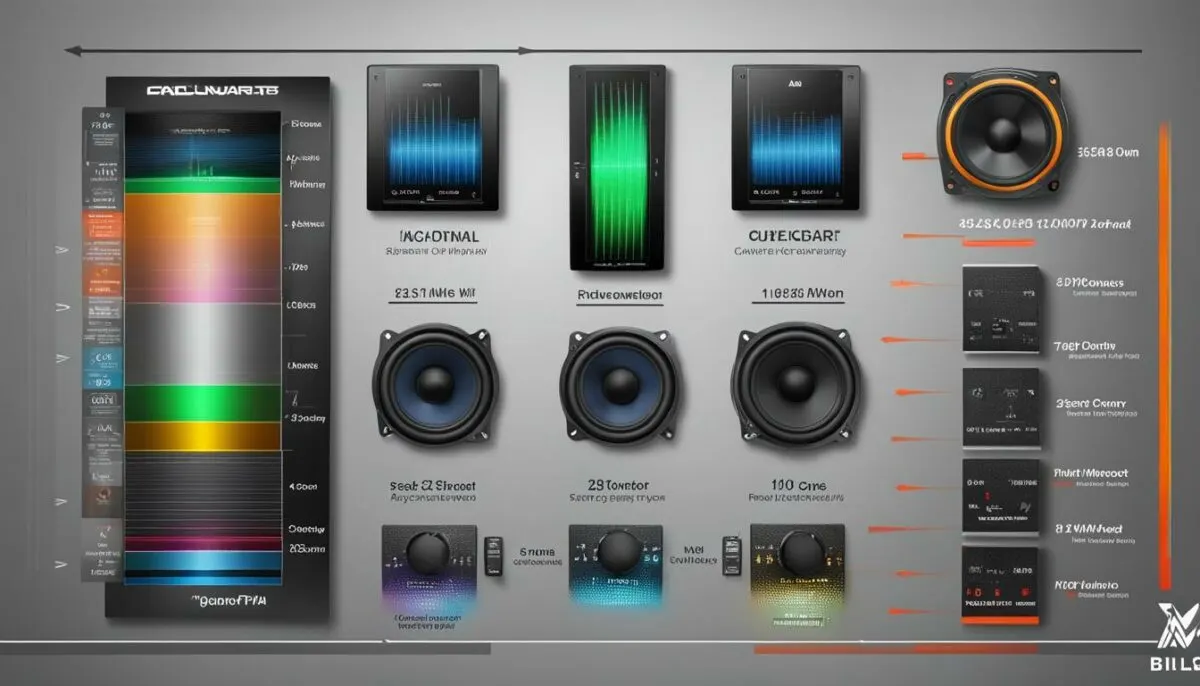
Car audio crossovers are an essential component of any sound system. They play a vital role in generating high-quality audio and protecting speakers.
Simply put, crossovers are electronic filters that divide the audio signal into separate frequency ranges. By doing so, they ensure that each speaker receives the appropriate range of frequencies, allowing sound reproduction to be focused on its strengths while reducing distortion.
There are two primary types of crossovers in car audio: passive and active crossovers. Passive crossovers are the most common and are typically integrated into the speaker system. In contrast, active crossovers are external devices that require a power source and offer more flexibility in signal processing and control.
Understanding the basic components and terminology of crossovers is key to optimizing their performance. The two main parts of a crossover are the high-pass filter and the low-pass filter. The high-pass filter allows only the higher frequency signals to pass through to the tweeters, while the low-pass filter only allows lower-frequency signals to the woofer and subwoofer.
When choosing a crossover, it is essential to consider factors such as power handling, compatibility with speakers, and budget. Selecting the right crossover can ensure that your car audio system receives the best possible sound quality.
In conclusion, understanding crossovers is critical knowledge for any car audio enthusiast. By knowing their role in car audio systems and their basic components, you can ensure you are choosing the best one for your system, optimizing its performance, and enhancing your listening experience.
Car Audio Crossover Installation
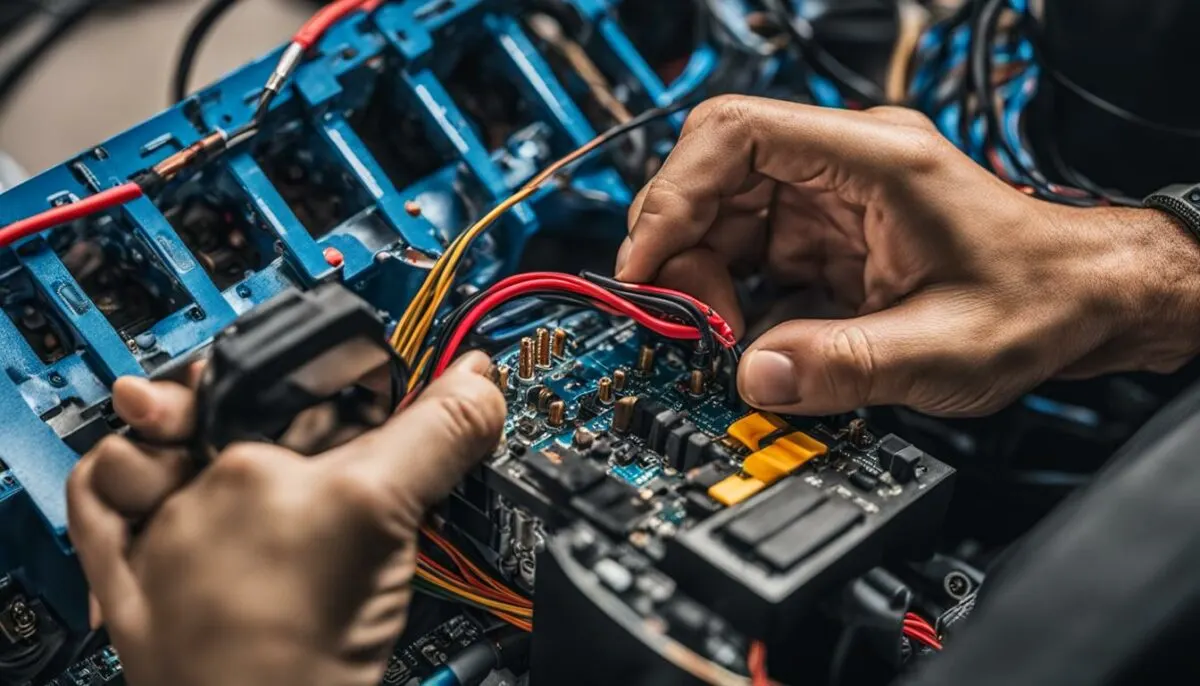
Installing a car audio crossover may seem intimidating, but it is a straightforward process that can be completed with some basic tools and understanding of your vehicle’s audio system. Before installing your crossover, it’s crucial to read the manufacturer’s instructions and ensure that you have all the necessary components and tools. Here are the general steps for installing a car audio crossover:
- Locate a suitable location for your crossover. It is best to place it in a secure and dry spot, away from any heat sources.
- Disconnect the negative terminal of the battery to avoid any electrical shorts or damage.
- Remove the stereo head unit from the dashboard and locate the speaker wires.
- Connect the crossover to the speaker wires, making sure to observe the correct polarity. You can use crimp connectors or solder the wires directly to the crossover terminals.
- Run the RCA cables from the head unit to the crossover. You may need to use a line output converter if your head unit does not have RCA outputs.
- Connect the RCA cables to the input terminals of the crossover.
- Connect the amplifier to the output terminals on the crossover.
- Reconnect the negative battery terminal and turn on the stereo to test the sound.
Once you have installed your crossover, it’s essential to adjust the settings properly for optimal performance. You can start by setting the crossover frequency based on the speaker specifications and adjusting the gain and EQ settings to achieve the desired sound quality.
Keep in mind that improper installation or settings can cause distortion, reduced sound quality, or damage to the speakers, so take your time and ensure that everything is correctly installed and adjusted.
“Installing a car audio crossover may seem intimidating, but it is a straightforward process that can be completed with some basic tools and understanding of your vehicle’s audio system.”
Best Crossover for Car Audio
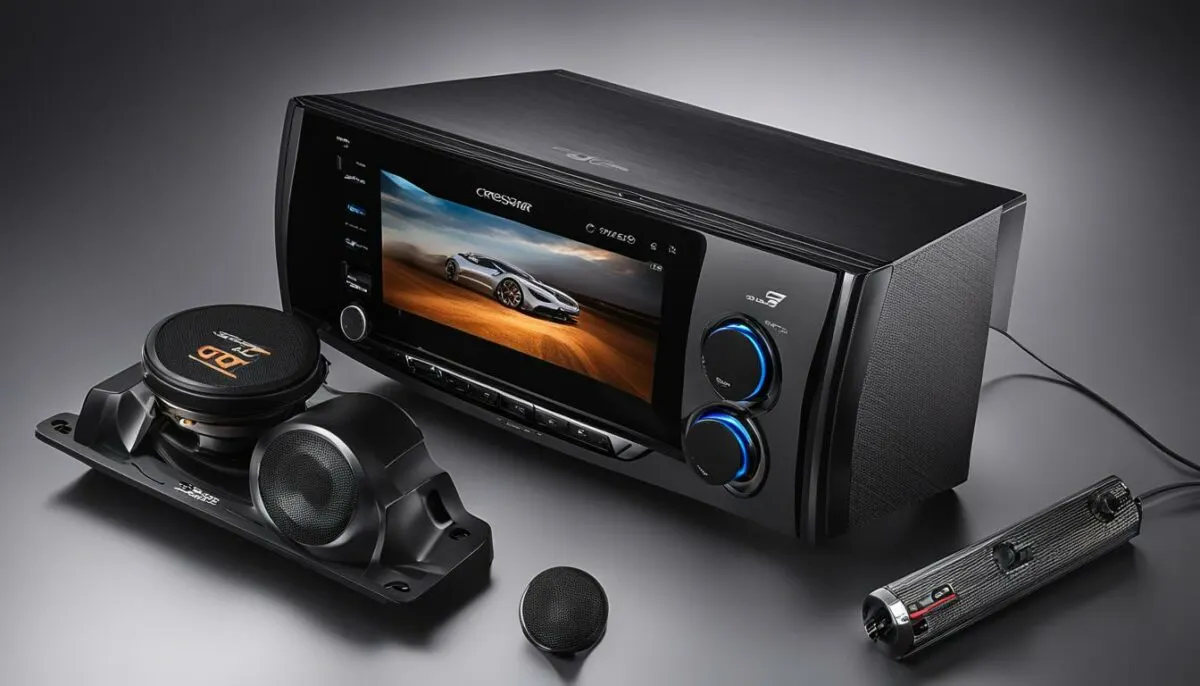
Choosing the best crossover for car audio can be a challenging task, but it is crucial to achieve a well-balanced and high-quality sound system. Here are some of the top options available:
| Crossover Model | Features | Price |
|---|---|---|
| Alpine Type-R X09 | 6-channel output, adjustable crossover points, time alignment | $399 |
| JL Audio TwK-D8 | 8-channel output, graphic EQ, digital signal processing, Bluetooth connectivity | $549 |
| Kicker KX2 | 2-channel output, adjustable crossover points, high-pass and low-pass filters | $99 |
| AudioControl LC7i | 6-channel output, AccuBASS circuitry, GTO signal sensing, high-level inputs | $189 |
It is essential to consider factors such as budget, number of output channels, crossover types, and features when selecting a crossover. The Alpine Type-R X09 and the JL Audio TwK-D8 are top-of-the-line models with advanced features and customization options. The Kicker KX2 is a more budget-friendly option with basic yet effective crossover functionality. The AudioControl LC7i offers high-level inputs and AccuBASS circuitry, enhancing factory-installed audio systems.
Ultimately, the best crossover for car audio depends on individual preferences and specific requirements. It is recommended to research and compare different models, considering the factors mentioned above, to make an informed decision.
Advancements in Car Audio Crossovers
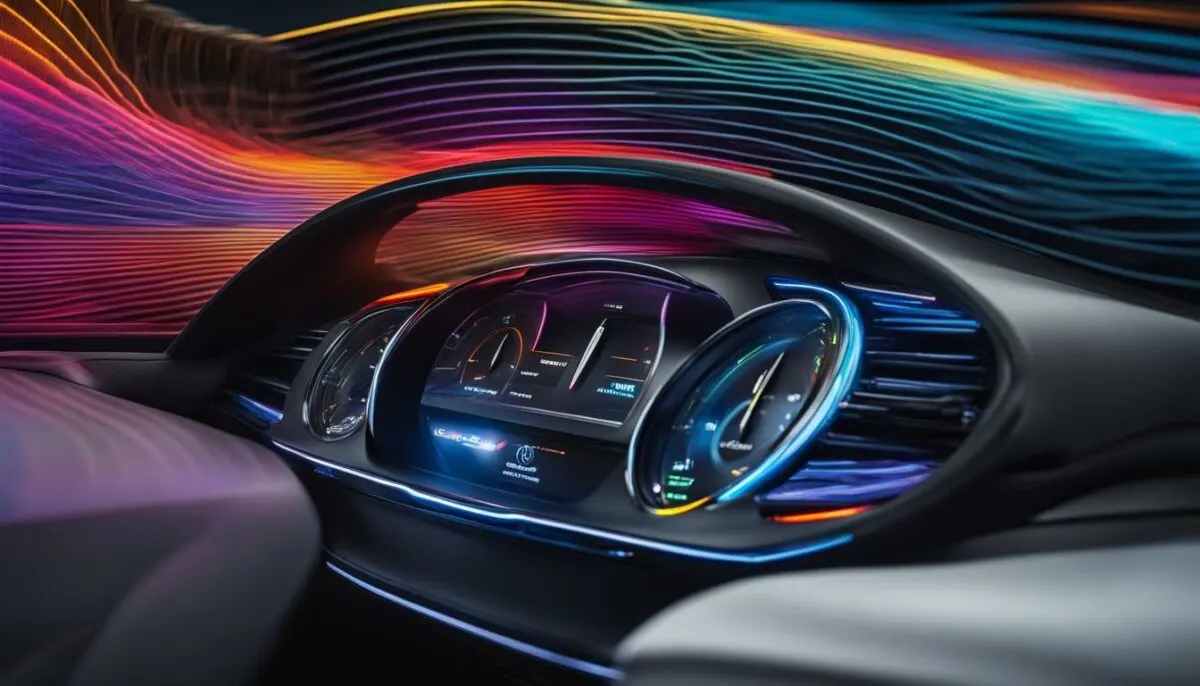
Car audio crossovers have come a long way since their inception, with various advancements made to improve their performance and flexibility. These advancements have been made possible through technological developments, innovative design features, and increased user accessibility. In this section, we will explore some of the latest advancements in car audio crossovers and their impact on sound quality and system integrations.
Digital Crossovers
One of the most significant advancements in car audio crossovers is the use of digital signal processing (DSP) technology. Digital crossovers utilize advanced algorithms and circuitry to separate audio frequencies and process them with greater accuracy and precision. They can also adjust the crossover settings in real-time, providing more flexibility and customization options for users.
Additionally, digital crossovers reduce the need for physical components, resulting in a much smaller form factor and easier installation. This technology has become increasingly popular in high-end car audio systems and has transformed the way crossovers are implemented and used in car audio setups.
Active Crossover Networks
Another significant advancement in car audio crossovers is the use of active crossover networks. Unlike passive crossovers that rely on external components, such as capacitors and inductors, active crossovers use built-in amplifiers to split the audio signal and send it to the appropriate speakers.
This method provides several benefits, including better sound quality, improved frequency response, and higher power handling capacity. Moreover, active crossovers allow for more fine-tuned adjustment options, providing greater control over the sound and performance of the system. They are often used in high-fidelity audio systems and professional audio setups, where precision and accuracy are paramount.
Wireless Integration
Wireless integration is another noteworthy advancement in car audio crossovers. With the increasing popularity of Bluetooth and Wi-Fi connectivity, crossovers can now be integrated wirelessly into a car audio system, eliminating the need for cumbersome wiring and cables.
This provides greater flexibility and convenience for users, allowing them to adjust their crossover settings remotely and without the need for physical connections. Furthermore, wireless integration enables seamless integration with other wireless devices, such as smartphones and tablets, enhancing the overall audio experience.
Conclusion
The advancements in car audio crossovers have transformed the way we approach and implement audio systems in cars. Digital crossovers, active crossover networks, and wireless integration offer greater performance, flexibility, and convenience than ever before. As technology continues to evolve, we can expect to see even more innovative designs and features in the future.
Troubleshooting Common Crossover Issues
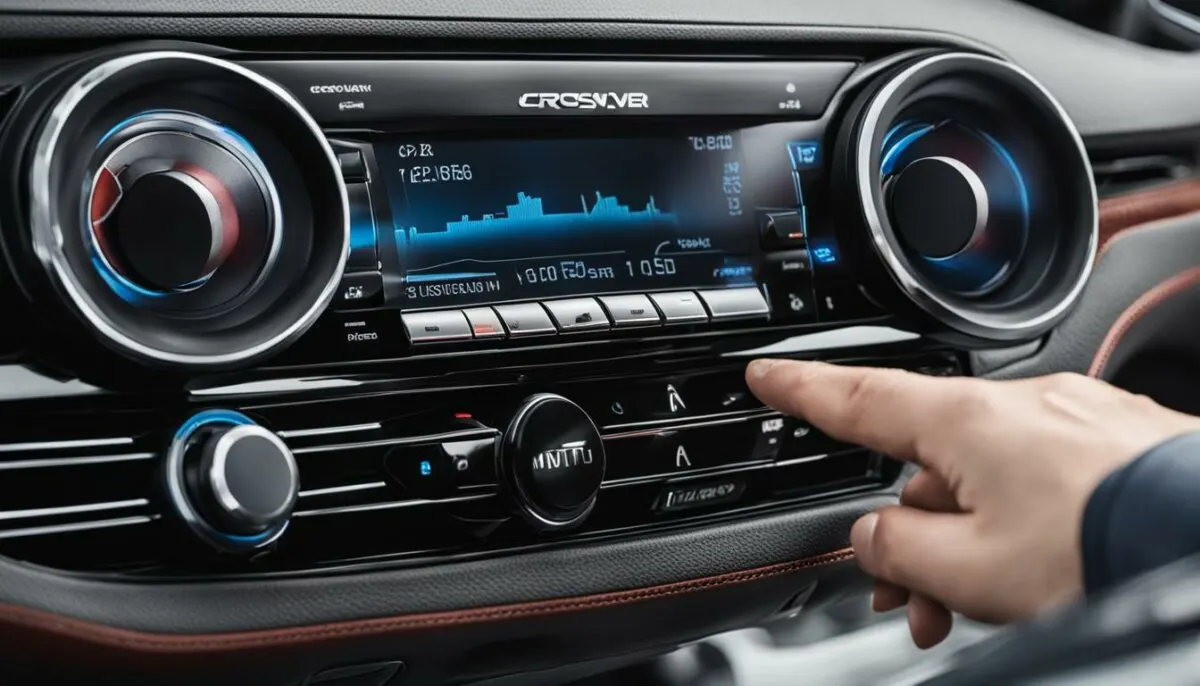
If you experience issues with your car audio system, specifically with your crossover, don’t panic. This section will cover some of the most common problems and how to fix them.
Problem 1: Distortion
If you notice your speakers are producing distorted sound, it could be due to several issues. Check your amplifier settings to ensure they are not too high. If the amplifier is working correctly, it may be that your crossover settings need adjustment. Try lowering the crossover frequency and test the sound again to see if it improves.
Problem 2: Noise Interference
If you hear a hissing or buzzing sound, it may be due to interference. This could be caused by a ground loop or power-related issues. Check all connections to ensure they are secure and not loose. If the noise persists, try adding a ground loop isolator to the system.
Problem 3: Incorrect Wiring
Another common issue with crossovers is incorrect wiring. A simple mistake in connecting the wires can cause significant sound quality issues. Double-check all connections to ensure they are properly connected and not shorting out. You can also check the user manual for your specific crossover for wiring diagrams and instructions.
Problem 4: Improper Crossover Settings
If your sound system isn’t producing the desired sound, it may be due to improper crossover settings. Ensure each speaker is receiving the appropriate range of frequencies by adjusting the crossover settings. You can also experiment with different crossover types to see how they affect sound quality.
If you are still experiencing issues with your crossover, consult a professional car audio technician for help. They can diagnose and fix the problem to ensure optimal performance of your car audio system.
Maintenance and Care for Car Audio Crossovers
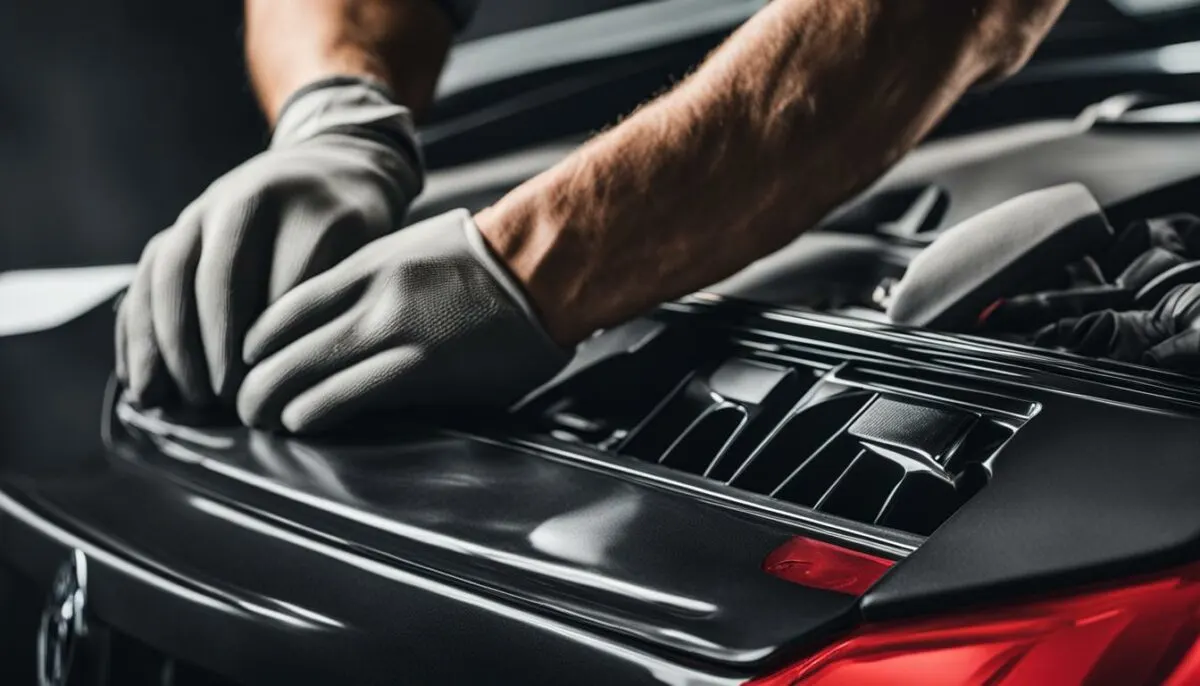
Car audio crossovers are essential components in sound systems, responsible for separating audio signals into distinct frequency ranges and directing them to the appropriate speakers. To ensure optimal performance and longevity, it is crucial to maintain and care for crossovers properly. Here are some maintenance tips to keep your car audio crossovers in peak condition:
- Regular cleaning: Dust, dirt, and other debris can accumulate on the crossover’s surface and impede its functionality. It is essential to clean the crossover regularly with a soft cloth to keep it dust and dirt-free.
- Inspect connections: Check the wiring connections for signs of wear and tear or corrosion. This is especially crucial for speaker wires, which can be exposed to moisture and humidity. Keep the connections tight and secure.
- Protect from damage: The crossover is a delicate component that needs extra care to avoid damage. Avoid dropping or hitting the crossover, and be gentle when handling it. Also, make sure to keep the crossover away from moisture, heat, and other elements that can damage it.
- Perform regular checks: Test the crossover occasionally to ensure that it is working correctly. Listen for any unusual sounds or distortion and check the crossover’s settings to make sure that they are optimized for your sound system.
By following these maintenance tips, you can extend the lifespan of your car audio crossover and enjoy optimal sound quality. Take care of your crossover, and it will take care of you!
Upgrading Your Car Audio System with a Crossover
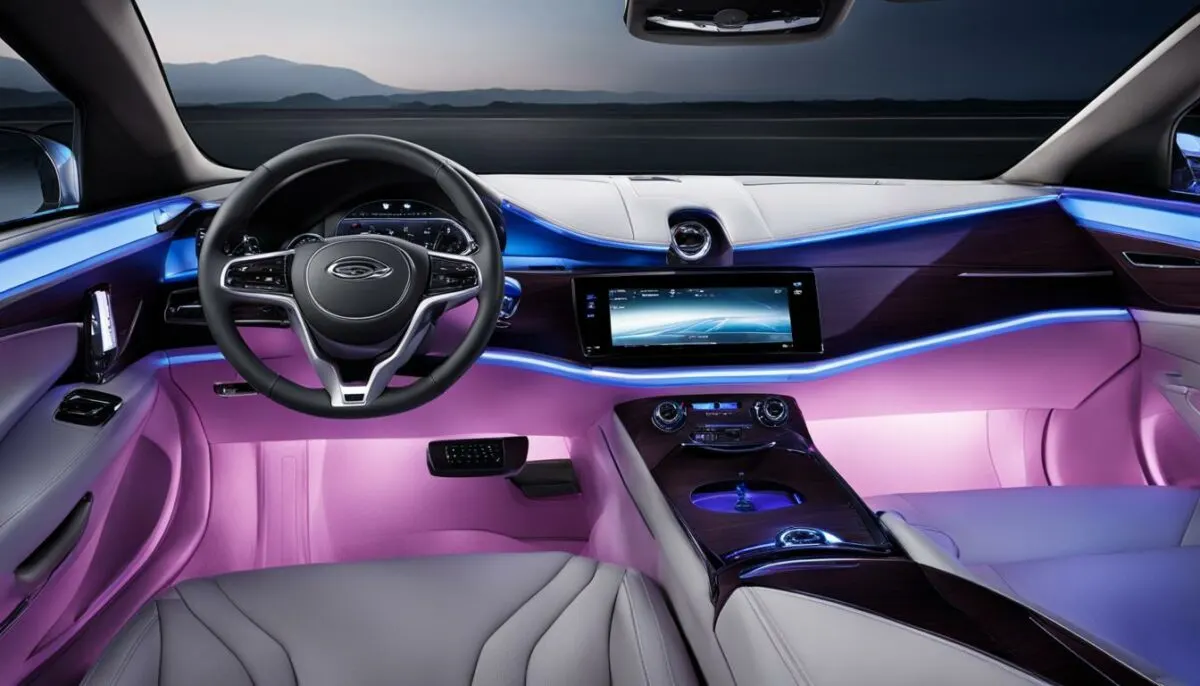
Adding a crossover to an existing car audio system can significantly improve sound quality and make the listening experience even more enjoyable. Upgrading the system with a crossover can enhance speaker performance, reduce distortion, and create a well-balanced sound system.
Integrating a Crossover into a Factory System
Integrating a crossover into a factory system can be challenging, but it’s not impossible. The best way to do this is by installing a passive crossover, which does not require a power source. Passive crossovers are relatively easy to install and can be tucked away out of sight.
A more seamless way to integrate a crossover is by using a processor that can be programmed to work with the car’s factory system. A digital signal processor (DSP) can be an excellent option since it offers more extensive control over the signal’s output. However, DSPs can be more expensive and require more technical expertise to install.
Adding a Crossover to an Aftermarket System
If the car has an aftermarket sound system, adding a crossover is relatively easy. Simply connect the crossover in-line with the speaker wires, and adjust the settings to achieve the desired sound quality. However, it’s essential to choose a crossover that is compatible with the speakers and amplifier to ensure optimal performance.
Choosing the Right Crossover
Choosing the right crossover is critical to achieving the desired sound quality. The crossover’s power handling capacity should match the amplifier’s power output to prevent damage to the speakers. It’s also crucial to consider the number of channels required and the crossover’s slope and frequency range.
To ensure that the crossover is compatible with the speakers, it’s essential to check the speaker’s nominal impedance and power handling capacity. Ideally, the crossover’s impedance should match that of the speakers.
Getting Professional Installation
Installing a crossover can be a complicated process and may require technical expertise. Therefore, it’s recommended to have a professional install the crossover to ensure that it’s integrated correctly and optimized for the best sound quality.
Upgrading your car audio system with a crossover can significantly enhance your listening experience by improving sound quality and maximizing speaker performance. Whether it’s an aftermarket or factory system, adding a crossover can create a well-balanced sound system that is easy to optimize and adjust to meet your sound preferences.
Tips for Choosing the Right Crossover

Choosing the right crossover for your car audio system can be a daunting task, but it’s essential to achieve the best sound quality possible. Here are some tips to help you select the most suitable crossover:
- Consider speaker compatibility: Ensure the crossover is compatible with your speakers to prevent damaging your equipment. Pay attention to the speaker’s impedance and power handling capabilities to ensure they match the crossover’s specifications.
- Determine the type of crossover: The type of crossover you choose will depend on your preference for sound quality and system components. Passive crossovers are easy to install and require no external power source, while active crossovers offer greater control and flexibility for the audio system.
- Decide on the crossover points: The crossover point determines the frequency range that a particular speaker receives. Choose crossover points that provide a smooth transition between frequency ranges and optimize sound quality.
- Pay attention to the slope: The slope determines how quickly the sound transitions from one frequency range to another. A steeper slope results in a sharper transition and can improve sound quality, but it may require more precise tuning and adjustment.
- Set a budget: Crossovers come in a range of prices. Determine your budget and priorities before making a decision to ensure you get the most value for your money.
Example: Comparison Table of Crossovers
The following table provides a comparison of three different types of crossovers based on their features and price range:
| Crossover Type | Features | Price Range |
|---|---|---|
| Passive Crossover | Easy to install, no external power required | $50-$150 |
| Active Crossover | Greater control and flexibility, adjustable crossover points | $150-$500 |
| Digital Crossover | Highly precise, allows for advanced tuning and customization | $500-$1000 |
Remember, when choosing the right crossover for your car audio system, it is essential to consider speaker compatibility, the type of crossover, crossover points, the slope, and your budget. By prioritizing your needs and preferences, you can select a crossover that optimizes your audio performance and enhances your listening experience.
Conclusion
In conclusion, crossovers are an essential component of any car audio system. Understanding what a crossover does in car audio and the types of crossovers available is crucial to achieving high-quality sound and protecting your speakers.
The benefits of using a crossover include separating different frequencies, reducing interference, and maximizing speaker performance. By optimizing the crossover settings for your specific audio system, you can create a well-balanced and clear sound.
When choosing the best crossover for your car audio system, consider factors such as power handling, speaker compatibility, and your budget. Researching and comparing different models and reading customer reviews can help you make an informed decision.
It’s important to properly install, maintain, and care for your car audio crossover to ensure optimal performance and longevity. If you encounter any issues with your crossover, troubleshooting tips are available to help you resolve common problems such as noise interference and incorrect wiring.
Crossovers continue to advance with new technologies such as digital crossovers and active crossover networks. Upgrading your car audio system with a crossover can bring even more significant enhancements to your listening experience.
By understanding the function and importance of crossovers in car audio and following the provided tips and information, you can enhance your audio system’s sound quality and protect your speakers for a more enjoyable listening experience.
FAQ
What does a crossover do in car audio?
A crossover in car audio systems is responsible for dividing the audio signal into different frequency ranges and directing them to the appropriate speakers. It ensures that each speaker receives the frequencies it is capable of reproducing, resulting in a more balanced and accurate sound reproduction.
What are the types of crossovers used in car audio?
There are three main types of crossovers used in car audio: passive crossovers, active crossovers, and digital crossovers. Passive crossovers are pre-built into speakers or can be installed externally. Active crossovers require separate amplifiers for each speaker, providing more control over the signal. Digital crossovers use digital signal processing to precisely divide the audio signal.
Why is a crossover important in car audio?
A crossover is essential in car audio systems because it helps prevent distortion, maximize speaker performance, and create a well-balanced sound system. Without a crossover, speakers may receive frequencies they aren’t designed to handle, leading to poor sound quality and potential damage to the speakers.
How does a crossover improve car audio?
A crossover improves car audio by separating frequencies, reducing interference between speakers, and ensuring that each speaker receives the appropriate range of frequencies. This enhances sound clarity, imaging, and overall audio performance in the car.
How do I set up a crossover in my car audio system?
Setting up a crossover in a car audio system involves adjusting crossover points, slope, and level settings. Start by understanding the capabilities and frequency response of your speakers. Then, connect the crossover between the head unit and the amplifiers. Adjust the crossover settings based on personal preferences and the characteristics of the speakers and audio system.
What should I know about car audio crossovers?
To understand car audio crossovers, it’s essential to know the basic components, functionality, and terminology associated with them. Components include crossover networks, crossover points, slopes, and filters. Understanding these elements will help you make informed decisions about selecting and using crossovers in your car audio system.
How do I install a car audio crossover?
Installing a car audio crossover involves connecting the input and output wires of the crossover to the appropriate connections in your audio system. It’s important to follow the manufacturer’s instructions, ensure proper grounding, and secure all connections. Consider the placement of the crossover for optimal performance and ease of access for adjustments if needed.
What are some of the best crossovers for car audio?
There are various high-quality crossovers available for car audio systems, and the best one for you depends on your specific needs and preferences. Some popular options include the Alpine PXE-0850S, JL Audio TwK-88, and AudioControl D-4.800. It’s advisable to research and compare different models based on factors like price, features, and customer reviews.
What advancements have been made in car audio crossovers?
Advancements in car audio crossovers include the development of digital crossovers and active crossover networks. Digital crossovers use digital signal processing to provide more precise control over the audio signal. Active crossover networks allow for individual amplification and signal processing for each speaker, resulting in improved sound quality and system flexibility.
How can I troubleshoot common crossover issues?
If you encounter common crossover issues such as incorrect wiring, noise interference, or improper crossover settings, there are troubleshooting steps you can take. Check the wiring connections, ensure proper grounding, adjust crossover settings, and eliminate any potential sources of interference. Refer to the manufacturer’s instructions and seek help from a professional if needed.
How do I maintain and care for my car audio crossover?
To maintain and care for your car audio crossover, regularly clean the unit and inspect the connections for any signs of damage or loose wires. Avoid exposing the crossover to excessive moisture or extreme temperatures. Protect the unit from physical damage and handle it with care during any maintenance or adjustment procedures.
How can I upgrade my car audio system with a crossover?
To upgrade your car audio system with a crossover, consider integrating it into your existing system. Determine the crossover points and settings based on your speakers and audio preferences. Properly connect the crossover between the head unit and amplifiers, making adjustments as needed to achieve the desired sound quality and performance.
What tips should I keep in mind when choosing a car audio crossover?
When selecting a car audio crossover, consider factors such as power handling, compatibility with your speakers, and your budget. Determine your specific needs and preferences, and research different models to find the one that best suits your requirements. Read customer reviews and seek professional advice if necessary.